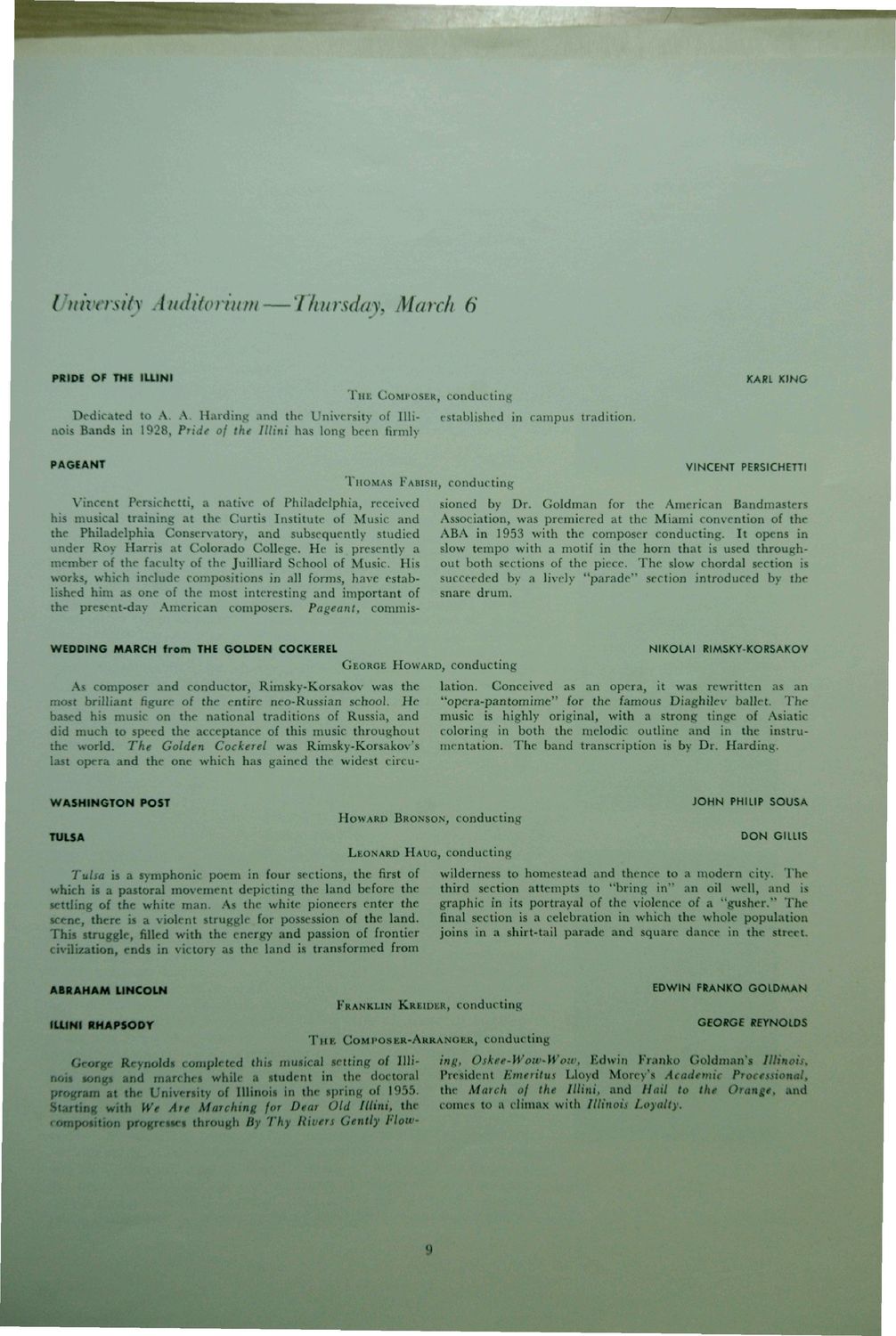Caption: Dedication - Band Building - Band Master's Association
This is a reduced-resolution page image for fast online browsing.

EXTRACTED TEXT FROM PAGE:
University Auditorium—Thursday, March 6 PRIDE OF THE ILLINI THE COMPOSER, conducting KARL KING Dedicated to A. A, Harding and the University of Illinois Bands in 1928, Pride of the Illini has long been firmly PAGEANT established in campus tradition, VINCENT PERSICHETTI THOMAS FABISH, conducting Vincent Pcrsichctti, a native of Philadelphia, received his musical training a t the Curtis Institute of Music and the Philadelphia Conservatory, and subsequently studied under Roy Harris at Colorado College. He is presently a member of the faculty of the Juilliard School of Music. His works, which include compositions in all forms, have established him as one of the most interesting and important of the present-day American composers. Pageant, commisWEDDING MARCH from THE GOLDEN COCKEREL sioned by Dr. Goldman for the American Bandmasters Association, was premiered at the Miami convention of the ABA in 1953 with the composer conducting. I t opens in slow tempo with a motif in the horn that is used throughout both sections of the piece. T h e slow chorda! section is succeeded by a lively "parade" section introduced by the snare drum. NIKOLAI GEORGE HOWARD, conducting RIMSKY-KORSAKOV As composer and conductor, Rimsky-Korsakov was the most brilliant figure of the entire neo-Russian school. He based his music on the national traditions of Russia, and did much to speed the acceptance of this music throughout the world. The Golden Cockerel was Rimsky-Korsakov 1 s last opera and the one which has gained the widest circu- lation. Conceived as an opera, it was rewritten as an "opera-pantomime" for the famous Diaghilev ballet. T h e music is highly original, with a strong tinge of Asiatic coloring in both the melodic outline and in the instrumentation. T h e band transcription is by Dr. Harding. WASHINGTON POST HOWARD BRONSON, conducting TULSA LEONARD HAUG, conducting JOHN PHILIP SOUSA DON GIUIS Tulsa is a symphonic poem in four sections, the first of which is a pastoral movement depicting the land before the settling of the white man. As the white pioneers enter the scene, there is a violent struggle for possession of the land. This struggle, filled with the energy and passion of frontier civilization, ends in victory as the land is transformed from ABRAHAM LINCOLN wilderness to homestead and thence to a modern city. T h e third section attempts to "bring in" an oil well, and is graphic in its portrayal of the violence of a "gusher." T h e final section is a celebration in which the whole population joins in a shirt-tail parade and square dance in the street. EDWIN FRANKO GOLDMAN FRANKLIN KREIDER, conducting GEORGE REYNOLDS T H E COMPOSER-ARRANGER, conducting ILLINI RHAPSODY George Reynolds completed this musical setting of Illinois songs and marches while a student in the doctoral program at the University of Illinois in the spring of 1955. Starting with We Are Marching for Dear Old Illini, the composition progresses through By Thy Rivers Gently Flow- ing, Oskee-Wow-Woio, Edwin Franko Goldman's Illinois* President Emeritus Lloyd Morey's Academic Processional the March of the Illini, and Hail to the Orange, and comes to a climax with Illinois Loyalty. 9
|